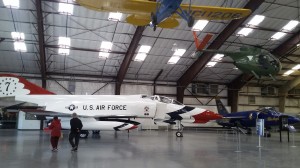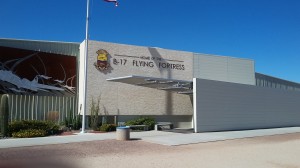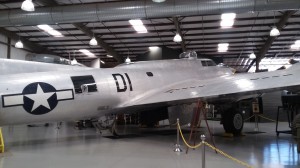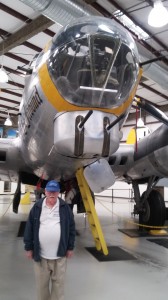A VISIT TO WESTERN ARIZONA – THE PIMA AIR AND SPACE MUSEUM
A VISIT TO WESTERN ARIZONA
This is the third in a series of articles about visiting Western Arizona
THE PIMA AIR AND SPACE MUSEUM
By Charles N. Stevens
Photos by Dolores Seidman
Today we head south toward Tucson, Arizona where we will visit the Pima Air and Space Museum. On the way we run into stiff cold winds that kick up the dust and limit visibility, a thin fog of dust. When we arrive at the museum we are told that there are so many school kids visiting that we’ll have to wait until they clear out. It’s still windy, gusts thrashing the trees and rippling the clothes of the school kids as they come out.
Once we are inside, after a bite to eat,we look out on many of the old military planes that are parked on the gravel, dust blowing among them. Part of the museum is devoted to the 390th Memorial Museum. The 390th was a bomb group flying with many other groups in the 8th Air Force out of England during World War II. As I flew with another bomb group during the same period, I’m interested in seeing it. To get to the museum, we walk outside to their special hangar.
Once inside their hangar, we head straight to a restored B-17, the four engine bomber the 390th flew, and the same type of plane I flew in as a bombardier. Several other people were looking at the plane, so I was able to answer many of their questions. Other than the B-17 exhibit, the hangar contained many other items important to the flyers and the ground crews.
We walk back to the main hangar of the museum and stroll around the military planes displayed. The planes are polished and beautiful and the floors among them so clean, they shine. Some of the famous planes displayed are the SR-71 Blackbird, the world’s fastest plane, an old B-18 Bolo bomber, an F-14 Tomcat, the F-4 Phantom, a B-34 Liberator and many other planes, both military and commercial.
At this point we take a bus tour of the planes stored outside. We cruise slowly as the guide tells us about the planes we pass. Most interesting were a few of the old president’s planes and several Russian MIGs. This part become a little tedious as the guide, who is full of information, tells us more about them than we could absorb, our bus only creeping along.
Once finished with the outside collection, we drive “next door” to Davis-Monthan Field to see Air Force planes that are not being used, but are stored. The process of going to the Air Force field becomes quite complicated. First they checked all our I.D.’s .when we got on the bus. Then at the field, we had to get off the bus, line up in an enclosure with the doors closed until the guards check our bus, making sure we’re all accounted for and that the bus is okay.
On our way again, we proceed slowly down the orderly ranks of military planes that are no longer in use. Photography is forbidden here. Unofficially, this area is called the “Bone Yard.” Although these planes are no longer in service, they are kept in tip top shaped in case they are ever needed. If it appears that they will never be used again, they are scrapped. They can also be used to supply spare parts to planes like those that are still flying. There are hundreds of planes parked on the flat field. In a way, it is sad to see all these planes just sitting there with no one wanting them. There is an abundance of old cargo planes on the field that once moved military cargo and troops all over the world. I am surprised they are not in use.
Time is getting late, and we still have a trip to the Saguaro National Forest ahead of us. Our adventure there will be in the next issue.

The planes in the Pima Air Museum are polished and the floors are immaculate.

A special building houses the memorabilia of the 390th Bomb Group, active in WWII in the bombing of Europe.

The group flew B-17's on their bombing raids.

The author poses by the B-17, the type of plane in which he was the bombardier.
MONTEREY PARK AUTHOR PUBLISHES 4th BOOK – Seeking More of the Sky: Growing Up in the 1930’s:
Charles “Norm” Stevens, a 43 year resident of Monterey Park has recently published his 4th book: Seeking More of the Sky: Growing Up in the 1930’s. This is the story of a young boy growing up in Inglewood, California in the l930’s. This was a time during the depression when unemployment was affecting many and the banks were closed, while the clouds of war were gathering in Europe. But he was lucky enough to be raised in a loving family, the power of that love reflected throughout his stories.
Stevens is the author of three previous books about his experiences during WWII:
An Innocent at Polebrook: A Memoir of an 8th Air Force Bombardier (Story of his 34 bombing missions from his base at Polebrook, England over Germany and France)
The Innocent Cadet: Becoming A World War II Bombardier (A prequel to the first, telling of his training in the U.S. before going overseas into combat.)
Back from Combat: A WWII Bombardier Faces His Military Future from Combat: (This book details the time from when he returned from combat in England until the end of the war.)
He is known to the readers of The Citizen’s Voice as the author of Travel Log Articles including “Cruising the Rhine and Mosel”,” Best of the West”, “In Search of Snow” , “From Paris to Normandy on the Seine”, and “Exploring New York”. He is retired, having taught for 32 years, primarily in the Montebello Unified School District.
Those interested in purchasing an autographed copy of any of his books, may contact the author at 323-721-8230 or Normstevens24@gmail.com.



